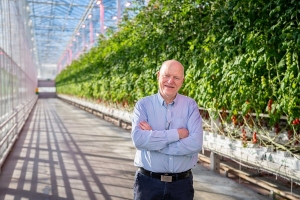Norway’s nursery grows more tomatoes and peppers year-round by using LED lighting
 Norwegian consumers are currently eating fruits and vegetables that have traveled thousands of kilometers from Southern Europe before they reach the shelves in Norwegian stores, which results in more imported food and a greater carbon footprint from its transport, compared to locally-grown crops. Now, Miljøgartneriet, Norway’s largest nursery, together with its partner LOG and Signify’s horticulture LED department, are taking the first steps in shortening the farm to fork distance by growing tomatoes and peppers year-round locally, under LED lights.
Norwegian consumers are currently eating fruits and vegetables that have traveled thousands of kilometers from Southern Europe before they reach the shelves in Norwegian stores, which results in more imported food and a greater carbon footprint from its transport, compared to locally-grown crops. Now, Miljøgartneriet, Norway’s largest nursery, together with its partner LOG and Signify’s horticulture LED department, are taking the first steps in shortening the farm to fork distance by growing tomatoes and peppers year-round locally, under LED lights.
The goal is to increase opportunities for local production and reduce the climate impact that comes from importing foreign produce. Signify has supplied Philips GreenPower LED toplighting compact for the 70,000 square meter greenhouse in Naerbø, Rogaland, Norway. With LED lighting, Miljøgartneriet gets the best possible conditions in the greenhouse. This is important since the lighting affects the plants’ photosynthesis, and that makes proper lighting extremely important for how well the plants grow and thrive.
For many years, Signify has studied lighting and plants and has found the perfect lighting recipe for tomatoes, peppers, cucumbers and other fruits and vegetables. Miljøgartneriet can therefore provide the plants with the right spectrum and light intensity at the right time. In this manner, they can control growth, planning and not least of all, increase productivity.
“Many supermarket chains want to be able to offer their customers fresh and tasty fruits and vegetables with a significantly lower carbon footprint than those that come from Southern Europe. This is something we can provide all year, thanks to our cooperation with Signify,” said Kåre Wiig from Miljøgartneriet. “We chose Signify because they can do more than just providing LED lighting. We have a good, close cooperation with their plant experts in order to get the most out of the lighting solution so that the vegetables get the best possible growing conditions. This means that we can easily adjust production as we get better at growing vegetables and Signify can also bring in different experts if necessary.”
Miljøgartneriet has installed Philips GreenPower LED toplighting compact, in combination with the GrowWise control system. This makes it possible to dim the lights so that growers can provide even light levels throughout the day and production cycle. Growers can also dim the lights when necessary. Either to save energy or when there is sufficient daylight.
Innovation in horticulture
Miljøgartneriet starts with 1 hectare of tomatoes and 0.4 hectares of peppers and intends to eventually expand this. The vegetables are already being harvested now and on their way to the stores throughout Norway.
Even though Signify has worked with LED lighting for greenhouses since 2012, there are many producers that are still not ready for the newest greenhouse lighting technology. Henrik Nørgaard, who is the Commercial Operations Manager for Agriculture at Signify, hopes that this cooperation with Miljøgartneriet, which is one of the leading actors in the market, can inspire other growers to install Signify Horti LED lighting and increase production.
“We are really proud that Miljøgartneriet sees the potential of cultivating with our lighting. Our lighting solutions should be seen as a cornerstone of production. We start with defining what is grown, the physical framework of the greenhouse, and the production goal, and based on this we create an optimal mix of micromoles, spectrum, and timing; the light recipe, together with the grower. With the solution, we can avoid the overuse of both water and electricity, as well as the environmental burden with transport from Southern Europe, and instead can get fresh, locally-produced vegetables in Scandinavia year-round,” said Nørgaard.
